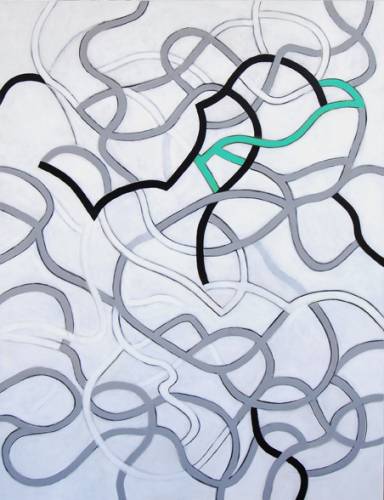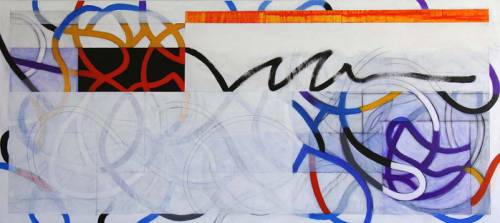by guest blogger John Borys
A marketing expert and artist shares his expertise with fellow creatives who want to make a brand presence.

Professional artists must develop a vision of the kind of work they want to produce and sell. It takes time to find your artistic voice and determine what you want to create, the way you want to create it (what medium), and what you want your work to communicate. It is an ongoing process.
There are many avenues you can follow, depending on what your work is about. Regardless of what road you take, you need to brand yourself as a particular kind of artist. Be specific.
Are you a realist? Is your work representational? Are you a conceptual artist whose focus is on the idea behind what the piece is about? Are you an abstract painter? Whatever you are creating has a context that existed even before you picked up a brush, or a conte pencil, or whatever your creative tool is.
Knowing what artists have done before and in what context their work was created at the time is important. Understanding what current artists are doing and the creative/social issues they’re wrestling with is also important in helping you to find your original voice. And then there’s perception — about the kind of artwork you produce and what a true artist is.
In my case, I am positioning myself as an American contemporary artist — American meaning that my experience comes from my point of view as an American. Contemporary meaning that I am focused on contemporary work, and Artist meaning I am an artist, not a provocateur, entertainer, intellectual or politician. Sometimes artists confuse these things and are not sure what kind of statement they want to make.
Your website needs to look like your work
I am in the process of changing mine right now. The “look” of the new site will be clean, minimal, sophisticated, and contemporary. The website design concept is to visually depict my art on the walls of a contemporary room, in a contemporary home.
Because my work is contemporary, part of my brand strategy is to show my work in a contemporary environment. Notice how the word contemporary keeps showing up here. That has been done on purpose. Whatever your style is, communicate this in your messaging.
If your work is quirky, whimsical or fun, your website, messaging, and social media efforts should reflect that vibe. If you are a traditional or realist painter, your website needs to look and feel like that. Colors, typeface, copy, images layout are all tools to further communicate your “brand,” whatever that might be.
Using tools to communicate your art, your brand
Once you figure out what kind of work you want to produce and what your art is all about, you’ll want to use the following tools to position yourself to your potential buyers, representatives, and professional contact who can refer you to other people.
Communication tools:
These include your website, blog, Twitter page, Facebook, Pinterest, Constant Contact, About.me, Issuu, target market mailing list, patrons list.
By utilizing these communications tools you can start developing your brand strategy. When I say brand strategy, I am referring to a lot of things. I was a creative director at advertising agencies for many years and messaging the “how you say things” is very important in the communications industry. Communication consists of only two things: what is said and how it is said. Persuasive creative messaging is paramount to your success.
Everyone knows the “what you do” part. Ask anybody “what they do” and they’ll tell you.
The “how” you communicate it is the focus here. Your work and your brand image need to reflect on another and be compatible. Remember: everything you project, produce, and say communicates something about you as a person, as well as an artist.
This includes where your work appears, how it is displayed, your creative persona, and your physical appearance. All these things work together to create a perception of you and your work in the minds of others, including prospective clients.
The ways artists market themselves has changed and continues to do so. Online galleries are interesting avenues. The number of artists on some of the sites can be overwhelming. Self-promotion, utilizing the communications tools mentioned here, will help you create awareness and allow you to reach a broader market with your work.
Selling work online is becoming more prevalent and will no doubt continue to thrive. Just look at the art being sold on Ebay. It’s important to think about your work and what context it is shown in. You are the steward of your own brand — your work will connect with certain audiences.
Visit galleries that feature artists whose work complements yours. After all, there is no point in trying to develop a relationship with a gallery that specializes in an abstract or contemporary art if you are producing representational or traditional art. It’s all part of knowing your brand, your art and where to show your work.
John Borys received his BFA in advertising design and fine art from North Texas State University, and went on to pursue a career in advertising. First as an art director, then a creative director, and ad agency owner, Borys’s career spans nearly 30 years as a successful, original, creative communicator.



John, Thank-you for the insightful article. I have recently changed my painting style and I see I really do need to change my website. Currently I have one toe in each camp.
some very sage advice!! it’s taken me more years than i care to say to get my art branded correctly and as you said, it’s an on-going process!
Hi John
You say “…meaning I am an artist, not a provocateur, entertainer, intellectual or politician. Sometimes artists confuse these things …”
I think that art is often (though not always) a profound mixture of some or all of these things and is the better for it.
So I am confused about what you say. Will you say more about this please?
Thanks
Brett
great article…good points about website etc…thanx
Good article John but I have problems with ‘Branding’. Yes it works! look at how the market loves ‘mature style’ art… think Rothko, Noland, Hockney, Picasso, Gauguin,Rousseau,Lichtenstein,Pollock… The stronger the style the more it appeals. The trouble is you get Demand Lead. You have to keep supplying what sells and experimentation is over. Art is not a business (obviously nearlyeveryone thinks it is) it is a continuing development. There is no destination except for those who want sell regularly. Sales need a brand…sure. Business needs a brand. Brands are for soap! Is so much famous art just soap? Probably!